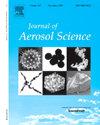Optimizing dry powder inhaler for laryngopharyngeal reflux: Effects of particle size and breathing technique
IF 2.9
3区 环境科学与生态学
Q2 ENGINEERING, CHEMICAL
引用次数: 0
Abstract
Dry powder inhalers (DPIs) were designed to treat lung diseases, but are now being repurposed to address laryngopharyngeal reflux, a condition with no effective treatment. This study assessed how particle size and breathing technique affect DPI deposition on the laryngopharynx using computational fluid dynamics (CFD). Time-dependent airflow and particle transport simulations were performed using the turbulence model on a 3-dimensional airway model of a healthy adult. Regional doses were estimated for sinusoidal breathing profiles with different durations (short vs. long inhalation) and depths (shallow vs. forceful inhalation). Three DPIs were simulated assuming log-normal particle size distributions with mass median aerodynamic diameters of 3 μm (DPI-1), 10 μm (DPI-2), or 50 μm (DPI-3) representing commercially available DPIs (DPI-1 and DPI-3) and a theoretical DPI optimized for laryngopharyngeal deposition (DPI-2). Particle size was the dominant factor with laryngopharyngeal doses of 5.3%, 20.3%, and 2.2% of the emitted dose for DPI-1, DPI-2, and DPI-3, respectively, with a normal inhalation (30L/min, 2s inhalation). Inhalation duration had a negligible impact on laryngopharyngeal dose for DPI-1 (short inhalation: 6.2%, long inhalation: 4.9%), DPI-2 (short inhalation: 20.6%, long inhalation: 20.3%) and DPI-3 (short inhalation: 1.9%, long inhalation: 2.3%). Similarly, inhalation depth had a negligible impact on the laryngopharyngeal dose for DPI-1 (shallow inhalation: 5.3%, medium inhalation: 5.8%, forceful inhalation: 6.5%), DPI-2 (shallow inhalation: 20.3%, medium inhalation: 20.0%, forceful inhalation: 21.4%) and DPI-3 (shallow inhalation: 2.2%, medium inhalation: 2.0%, forceful inhalation: 2.2%). In summary, our simulations suggest that particle size affects the laryngopharyngeal dose more significantly than the breathing technique with a mass median aerodynamic diameter of being predicted to maximize drug delivery to the laryngopharynx. Further studies are needed to validate these findings in larger cohorts.

优化干粉吸入器用于喉部反流:颗粒大小和呼吸技术的影响
干粉吸入器(dpi)被设计用于治疗肺部疾病,但现在被重新用于治疗喉部反流,这是一种没有有效治疗方法的疾病。本研究利用计算流体动力学(CFD)评估了颗粒大小和呼吸技术对喉部DPI沉积的影响。采用k−ω湍流模型对健康成人气道三维模型进行了随时间变化的气流和颗粒输运模拟。对不同持续时间(短吸入与长吸入)和深度(浅吸入与强吸入)的正弦呼吸谱进行区域剂量估计。采用对数正态分布对3种DPI进行了模拟,其质量中值气动直径(d50)分别为3 μm (DPI-1)、10 μm (DPI-2)和50 μm (DPI-3),分别代表了市售DPI (DPI-1和DPI-3)和针对咽部沉积优化的理论DPI (DPI-2)。DPI-1、DPI-2和DPI-3在正常吸入(30L/min,吸入2s)的情况下,喉部剂量分别占放射剂量的5.3%、20.3%和2.2%。吸入时间对DPI-1(短吸入:6.2%,长吸入:4.9%)、DPI-2(短吸入:20.6%,长吸入:20.3%)和DPI-3(短吸入:1.9%,长吸入:2.3%)的喉咽部剂量影响可忽略不计。同样,吸入深度对DPI-1(浅吸入:5.3%,中吸入:5.8%,强力吸入:6.5%)、DPI-2(浅吸入:20.3%,中吸入:20.0%,强力吸入:21.4%)和DPI-3(浅吸入:2.2%,中吸入:2.0%,强力吸入:2.2%)的喉咽部剂量的影响可以忽略不计。综上所述,我们的模拟表明,颗粒大小对喉部剂量的影响比呼吸技术更显著,预测质量气动中值直径为d50=10μm时,可以最大限度地将药物输送到喉部。需要进一步的研究在更大的队列中验证这些发现。
本文章由计算机程序翻译,如有差异,请以英文原文为准。
求助全文
约1分钟内获得全文
求助全文
来源期刊

Journal of Aerosol Science
环境科学-工程:化工
CiteScore
8.80
自引率
8.90%
发文量
127
审稿时长
35 days
期刊介绍:
Founded in 1970, the Journal of Aerosol Science considers itself the prime vehicle for the publication of original work as well as reviews related to fundamental and applied aerosol research, as well as aerosol instrumentation. Its content is directed at scientists working in engineering disciplines, as well as physics, chemistry, and environmental sciences.
The editors welcome submissions of papers describing recent experimental, numerical, and theoretical research related to the following topics:
1. Fundamental Aerosol Science.
2. Applied Aerosol Science.
3. Instrumentation & Measurement Methods.
 求助内容:
求助内容: 应助结果提醒方式:
应助结果提醒方式:


